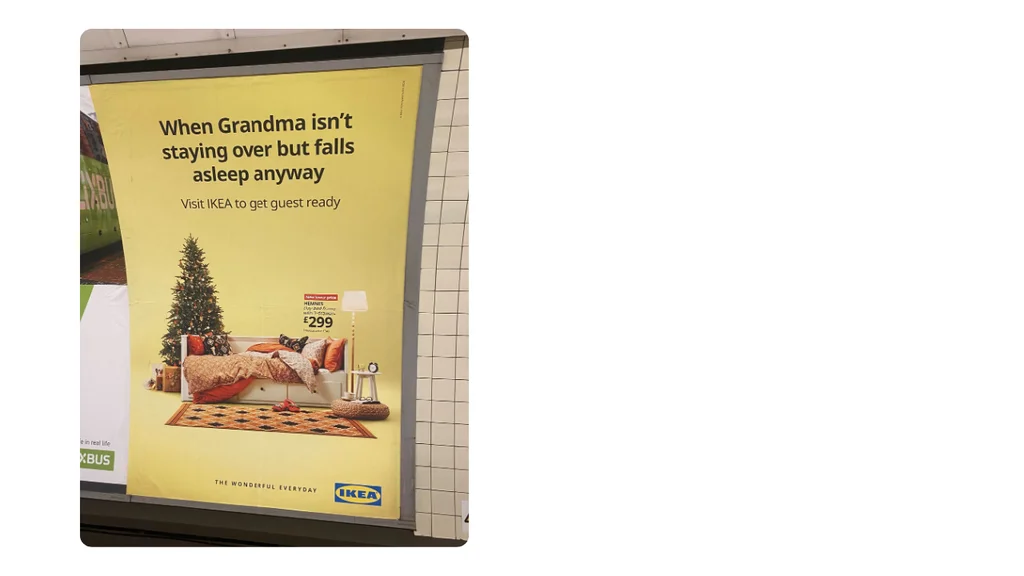Retailers’ Christmas adverts have become a big event in recent years and several have attracted controversy for their depictions of the festive period and UK society more broadly.
Harriet Bailiss, Joint Head of the Age Without Limits Campaign, looks at this year’s offerings from the UK’s biggest retailers and their representation of older people.
With just weeks to go until Christmas, retailers have come out all guns blazing with their festive adverts designed to pull on the heartstrings and purse strings in equal measure.
Much more than an opportunity to showcase a retailers’ gift options or dining table showstopper, these adverts have become an event in themselves, aspiring to say something meaningful about Christmas and the world we live in more broadly.
Christmas is a time for everyone, “the old and the young” as John Lennon famously sang, but older generations can often be forgotten about by retailers focussing on the magic and wonder that children and families feel at this time.
In fact, older people are frequently neglected by advertisers all year round.
Research we carried out earlier this year reveals more than half (53%) of people aged 50 and above believe the depiction of older people in the media and advertising is negative and stereotypical and does not reflect their lives.
Other studies have shown that fewer than one in three (29%) TV advertisements feature characters aged 50 years or older.
By failing to speak to this significant proportion of society, it is the retailers that are missing out. Over 50s are already responsible for half of all household spend in the UK. And this is only set to grow.
By 2040, the over 50s consumer group are projected to spend £550 billion a year – more than double the purchasing power of younger households.
What older consumers want is to see themselves, their lives and their experiences reflected back to them in the adverts they watch. Tokenistic or stereotypical depictions will not cut it.
Guidance highlighted by the Unstereotype Alliance, an organisation set up by UN Women to address stereotypes in marketing, makes clear how to achieve this by:
- Depicting people as empowered actors
- Refraining from objectifying people
- Portraying progressive and multi-dimensional personalities
With this in mind, I have been running my eye over the latest Christmas adverts with an age-inclusive lens to see whether retailers are wising up on how to better reach older consumers.
Lidl Presents: A Magical Christmas
Age-inclusive rating 3/10
Lidl’s offering this year is ticking a lot of the festive classics; sledging, snow, sprouts and even a little sentimental poem.
The advert centres on Christmas being a time for children and families.
The one older character we see is the classic doddery but dear cliché, an older woman struggling on her own in the snow with her Christmas shopping and reliant on the help of the younger generation.
This may seem like a harmless or affectionate stereotype, but consistently representing older people in this way perpetuates the idea older people are helpless, avoids showing the nuances of real older people, and contributes to the negative attitudes towards ageing many of us hold.
To paraphrase the Unstereotype Alliance; stereotypes reflect deep-rooted ideas of age and ageing. Negative, diminished conceptions of older people are a major barrier to equality which is why it is important to tackle those stereotypes wherever they appear.
IKEA – When Grandma isn’t staying over but falls asleep anyway
Age-inclusive rating 4/10
This advert plays on the old stereotype of Grandma nodding off in front of the TV (with the insinuation this was maybe after a festive tipple or three?).
While there’s no doubt some nugget of truth to this stereotype to make it resonant with so many, it does also perpetuate a negative image of older people with less energy possibly becoming a bit of a burden the family now has to deal with.
With the excitement of early morning present wrapping and excess in food and drink, post-prandial napping is a risk for everyone of all ages during the festive period, so why single out Grandma here? Why again is the only older person in the ad a stereotype?

Debenhams - Duh, Debenhams
Age-inclusive rating 4/10
Kudos to Debenhams for choosing an older woman to front their advert in Liz Hurley, 59, but there’s not much else to like about this advert from an age-inclusivity angle.
A joke about avoiding long queues necessitates a character ageing at rapid speed to ultimately depict an unkempt, hunched and pitiful old man.
Of course it can seem po-faced to criticise what is just a joke but representation matters and not just to charities with a focus such as ours, but to older consumers who become sick of the image of older people reflected back at them from the TV which doesn’t reflect their own self-perception or lifestyle.
The advert also loses points for its insinuation that only idiots go to high-street stores to do their Christmas shopping which is insulting to anyone who does not have access to the internet, finds it hard to navigate or simply chooses not to.
The Gifting Hour – John Lewis & Partners
Age-inclusive rating 2/10
No Christmas advert round-up would be complete without the inclusion of John Lewis.
The brand has set the bar high for Christmas adverts, who could forget Monty the Penguin, the hare and the bear, the endless cycle of tearjerker acoustic covers?
This year’s eagerly anticipated version has raised eyebrows for its much more direct appeal to the power of shopping and gifting.
But from an age-perspective lens, what is disappointing about this year’s effort is the complete lack of representation of older people anywhere.
The focus is purely on one demographic of shopper, presumably the one that the brand prizes above all others. Having had previous adverts such as 2011’s Man on the Moon so focussed on age inclusivity, this year’s version feels pretty flat and ordinary.
Sainsbury’s BIG Christmas
Age-inclusive rating 7/10
Sainsbury’s have rolled out the BFG guns for their festive offering this year.
The choice of source material is not without risk with controversy around Roald Dahl’s views and rewrites of some of his material.
But overall the advert gets the sentimentality, humour and essence of Christmas just about right.
To be super critical, the BFG character certainly leans hard into negative older people stereotypes; an eccentric loner, with exaggerated facial features, finds a sort of salvation through interactions with a purer, younger generation.
This is a stereotype that is much more pronounced and lacking in nuance in a 90 second TV advert compared to the original 200-page children’s book.
M&S Christmas Food
Age-inclusive rating 8/10
Another retailer getting the tone right is M&S, thanks in large part to the celebrity fronting their adverts this year.
At 67-years-old and embracing her natural grey hair, Dawn French is a great choice to front the advert.
An older person but not framed within any of the stereotypes, in the advert she is seen transformed from a slightly Christmas fatigued home a loner into the ultimate party host of a gathering bringing together an impressive all-ages party.
She is a multi-dimensional character and empowered in the advert, the centre of the action and the individual bringing a whole community together (with a little help from her fairy).
Boots Christmas Advert 2024
Age-inclusive rating 7/10
Boots Christmas offering this year has attracted criticism in some circles this year for apparently being “too woke”.
From an age lens perspective, 61-year-old Adjoa Andoh is a wonderfully glam choice.
Again the older person is the empowered centre of this advert, taking charge of the most important day in the Lapland calendar.
But in striking a blow for gender equality in celebrating the good woman behind every good man, we again see the classic tired out old person snoozing trope as Mrs Christmas gets to work while Santa catches 40 winks.
So overall, we see retailers attempting to embrace a diversity of diversity as they attempt to depict what a modern Christmas looks like. This is admirable.
But trying to crowbar this into a 90-second advert, with a hefty dollop of sentimentality and humour, can mean at times that the representation of older people is reduced to caricature which ends up reinforcing negative stereotypes.
While rarely is this done with malice, it still has the power to be harmful. Harmful to the self-image of older people watching, harmful to all viewer’s expectations and understanding of ageing.
But also harmful to the businesses themselves who may find themselves missing out on older consumers if they get their depiction of them wrong. So plenty of reasons for retailers to be extra vigilant in getting this right, to everyone’s benefit.
